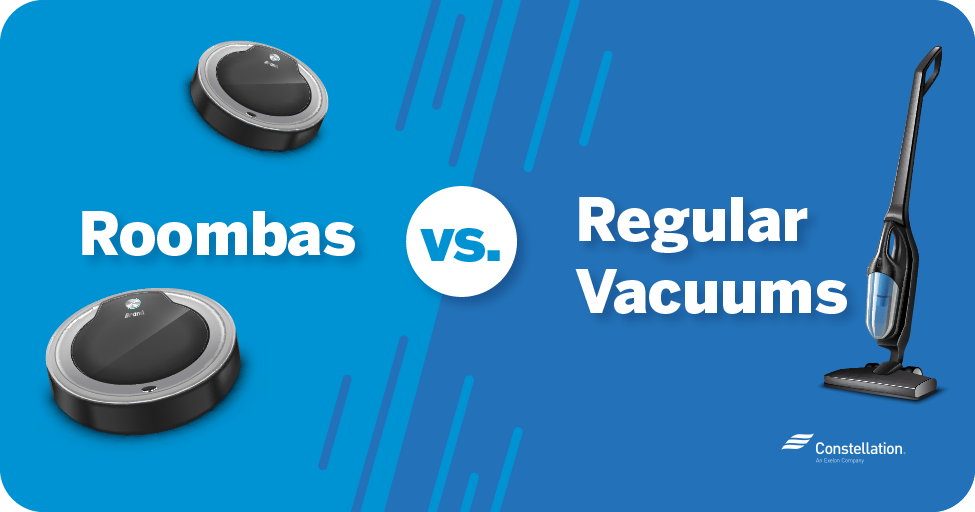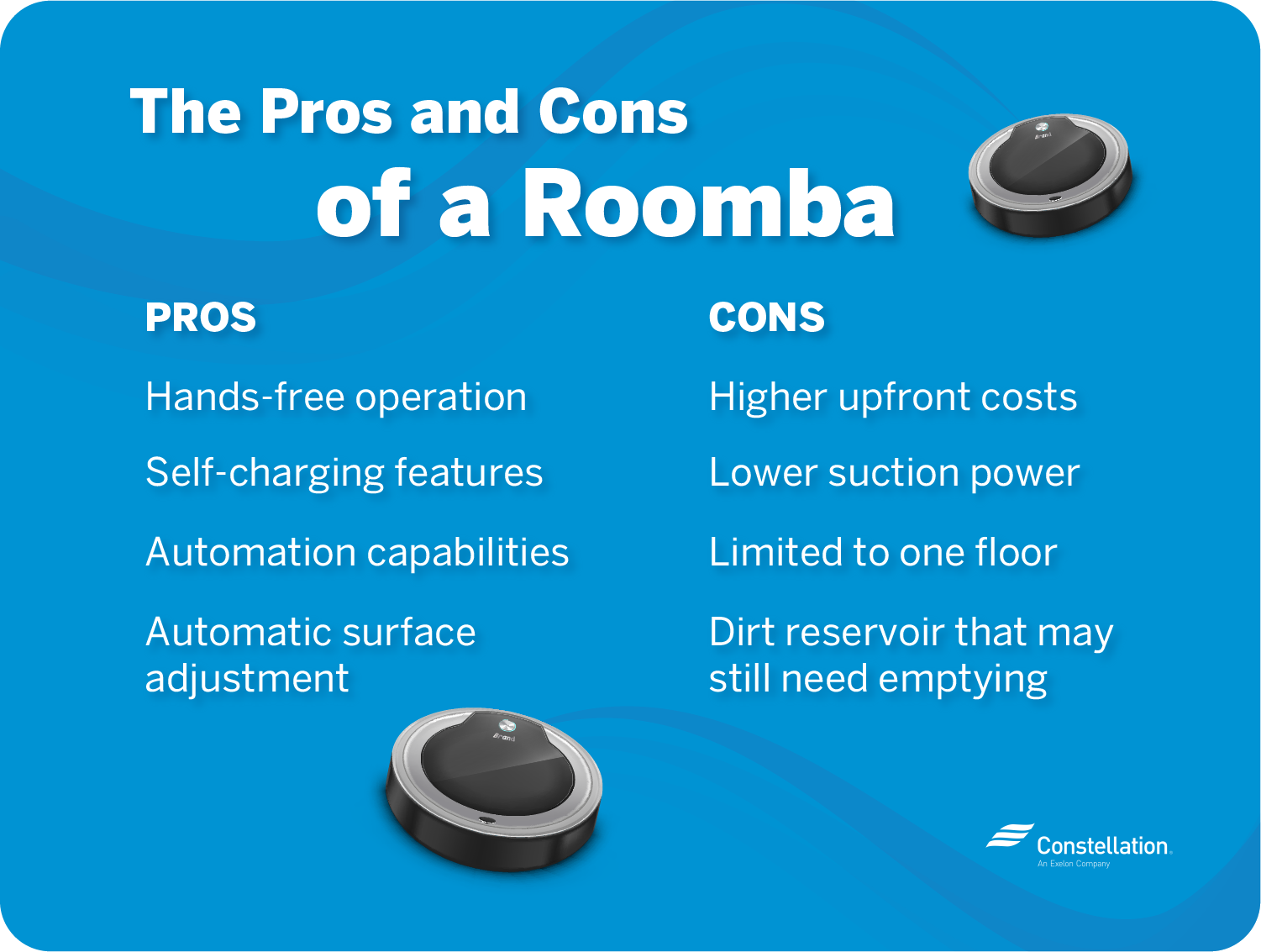
- Category:
Home Energy Savings -
Last updated:
September 15, 2020
Roomba vs. Upright Vacuums: Which Uses More Energy?
If you’re in the market to buy a vacuum cleaner, you have many options. It used to be that the choice you had was classic upright vs. canister vacuum. More and more, though, the decision comes down to Roomba® vs. regular vacuum cleaner.
Here, we’ll explore the reasons for buying a robot vacuum, looking closely at Roomba pros and cons. You may not know it, but your choices affect energy consumption. And as part of your decision, you’ll want to factor in the purchase price and the cost to operate the vacuum over its lifetime.
How does a robotic vacuum work?
When considering a Roomba vs. an upright vacuum, it helps to understand how they work and the attractive features robot vacuum cleaners offer you. The most obvious of the benefits of a robot vacuum is that it does the work with no effort from you. If you hate vacuuming, the answer to the question “should I get a robot vacuum?” is easy.
But that isn’t the only consideration. Some robot vacuums use sensors, mapping software and artificial intelligence to actually learn the layout of your home and how to most efficiently clean it. You can preprogram when your robot vacuum cleaner operates, or order it to start cleaning with a voice assistant like Alexa or Google Home that’s part of your home network.
Can a Roomba replace your upright vacuum cleaner?
If the choice comes down to Roomba vs. regular vacuum, the layout of your home and the dirt you encounter makes a difference. You get the best benefits from a robot vacuum if you keep your home generally clean. If you have kids, pets and high-traffic areas, a Roomba may not be able to keep up. Robot vacuums have lower suction, so their cleaning power isn’t as strong. They also struggle if you have stairs and too much clutter in your home.
So, can a Roomba replace the vacuum cleaner you’re used to? Possibly. If you’ve already invested in home automation, a robotic vacuum makes more sense: It’s convenient to add a smart device to an already existing home network, and you may be comfortable with a robot vacuum if you’re used to a smart home lifestyle. But there are other Roomba pros and cons to consider, such as robot vacuum energy use.
Robotic vacuum vs. regular vacuum energy use
When comparing a robot vacuum vs. a regular vacuum, energy use matters. The cost adds up over time. The difference in power consumption can vary with the size of your house, the frequency of your vacuuming routine and the efficiency of the vacuum you use. And because conserving energy is important, it pays to consider energy consumption among the pros and cons.
In general, you’ll find a robotic unit to be the most energy efficient vacuum.
Roomba energy consumption
Roombas charge most efficiently in their home base. Typical home base charge time is three hours, drawing 28 watts. They draw low power in standby mode to trickle-charge the battery slowly until the next use. Once fully charged, Roomba energy consumption is about 3.6 watts in standby mode. If you need a faster charge, you can use the charger, but most people wait a day or two between vacuuming sessions.
What’s more, when you automate appliances that use the most energy, you can optimize efficiency. That can really help in curbing your robot vacuum’s energy use. But the version and model you have makes a difference. Older robot vacuums could end up wandering and wasting energy.
Upright vacuum energy usage
How much power an upright vacuum uses depends on many factors, including the size of your house, type of flooring, how often you vacuum and, importantly, the wattage your appliance uses. Upright vacuum energy consumption averages about 1,400 watts but ranges between 500 to 3,000 watts. So, in most comparisons of Roomba vs. upright vacuum power usage, the Roomba is more energy efficient.
Features like power-assisted drives, turbo rug attachments, lights and sensors consume more power in upright vacuum cleaners. Keeping moving parts clear of hair and dirt helps any vacuum operate more efficiently, as does frequent replacement of filters and emptying dirt receptacles.
Weighing Roomba pros and cons
Energy consumption is an important difference when choosing a Roomba vs. an upright vacuum, or any robotic vacuum vs. a regular vacuum. Picking energy-efficient appliances is one of the best ways to save energy. But there are other factors to weigh before making your decision.

The benefits of a robot vacuum cleaner
Convenience barely scratches the surface of the benefits of a robot vacuum cleaner. Here are more reasons why Roombas so often win the robotic vacuum vs. regular vacuum debate:
- Hands-free operation. Hands-free means you rarely need to touch your Roomba. It cleans on its own and returns to its charger on its own. All you need to do is periodically empty the dirt receptacle — although some newer models even do that.
- Self-charging features. Most robotic vacuums return to their home bases to recharge when the battery runs low.
- Automation capabilities. Roombas easily integrate with smart speakers and voice assistant devices in your smart home network. If you have smart home technology in place, you can schedule regular cleaning or order vacuuming on demand.
- Automatic surface adjustment. You won’t be fumbling with attachments for hard floors and rugs. Your robotic vacuum automatically senses and adjusts for varied flooring types.
The disadvantages of a robotic vacuum cleaner
Roombas don’t always come out on top when the choice is robotic vacuum vs. regular vacuum. Your home and lifestyle may not be suitable, or the benefits of a robot vacuum may not be worth the costs. The following are some Roomba disadvantages:
- Higher upfront costs. Robot vacuums, especially the high-end ones with the most attractive features, are much more costly than the average upright vacuum cleaner.
- Lower suction power. In comparing a Roomba vs. a regular vacuum, the lower wattage of these and other robotic vacuums can be a disadvantage. Lower wattage means lower suction power.
- Limited to one floor. One of the major limitations of a robot vacuum is that it can’t deal with stairs. If you have multiple levels, like a sunken living room or a split-level home, a Roomba may not be for you.
- Dirt reservoir that may still need emptying. The newest, most expensive models empty their own reservoirs into their home bases. But you still have to deal with the dirt when you empty the home base, just less frequently than you would if you had to empty the unit itself.
Deciding between a Roomba vs. an upright vacuum
The Roomba vs. regular vacuum decision can be difficult with so many choices available today. Should you get a robot vacuum? In the end, the choice you make comes down to your budget, the type of home you have, how often you vacuum and what features you want.
But when considering cost, be sure to factor in the total cost of ownership. Here’s an energy saving tip: Factor in the cost of the energy your vacuum uses over its lifetime, which could easily be 10 years or more. It might make the purchase price seem small by comparison.




